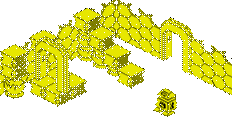Camputers Lynx
Vital Statistics
Introduced
March 1982 |
|
![]()
What's it like today?
|
The Lynx 48 was a direct competitor of the Sinclair ZX Spectrum and the Oric 1. It was a good machine but mainly lacked software. Several models were quickly made available with 48k, 96k or 128k RAM, and it was possible to reach 192k with RAM expansions on board ! There is even a monitor program in the Lynx's ROM which allows the user to write and edit programs written in machine code. The 96k and 128k versions featured 4 KB additional ROM memory (mirrored twice for obscure reasons) with lots of extra commands for sound effects such as laser and klaxon, and for using 24 KB dedicated RAM as data space. The Lynx Basic has some unique features unseen on other systems of its category, like REPEAT-UNTIL and WHILE-WEND statements, and automatic indenting of procedures. The graphical capabilities were excellent, especially with the 128k model and CP/M can be used with the optional 5.25" disk-drive on 96k or better models.
Despite all this, however, the Lynx had little success outside Great Britain. The designer of the Lynx is John Shireff, an ex-drummer. Camputers started life as an offshoot company of GW Design Services, an electronics design company based in Cambridge, UK. They were contracted to design a Z80A-based microcomputer which never materialized into a deal, but is gave owner Richard Greenwood an idea to branch out into computers. Around this time, Shireff joined GWDS as a circuit and systems designer, while they were developing peripherals for the BBC Micro and the NewBrain. In March 1982, Greenwood committed to building their own home computer, and established a team to create what would become the Lynx. The BASIC interpreter software was written by a maths graduate called David Jansons, who joined at the start of the project, and the hardware drivers put together by Shane Voss and Fiona Miller. Shireff had designed the Lynx to be expandable from the outset, with CP/M as the primary operating system. Production began in December 1982, after some delays following its initial exposure to the public at the Personal Computer World show in September, and the reports from the media were favourable. However, after initial sales surge, in March 1983 cashflow was becoming a problem for the company. Based on support from major retailers, they floated the company hoping to raise £900,000, and in addition to a loan from barclays of £300,000, they plan was to increase production, develop more software, and complete development work on other Lynxes in the line-up. In September 1983, the 96K Lynx went on sale, and in December 1983 the company launched the 128K model, but by that time, computers weren't selling as the hot Christmas favourite anymore. Reatilers began questioning the health of Camputers PLC. By May 1984, after reaching agreement with a financial consortium and papers having been drawn up, the buyer got cold feet and pulled out. 24 members of staff were laid off, including Shireff. Several companies expressed an interest in buying the business, and in November 1984, a firm called Anston Technology took over. A re-launch was planned but never happened, and in June 1986 Anston sold everything - hardware, design rights and thousands of cassettes - to the National Lynx User Group. The group planned to produce a Super-Lynx but was too busy supplying spares and technical information to owners of existing models, and the project never came into being. It is estimated a total of 30,000 Lynxes were sold, with a third of them in the UK and two thirds in Europe.











